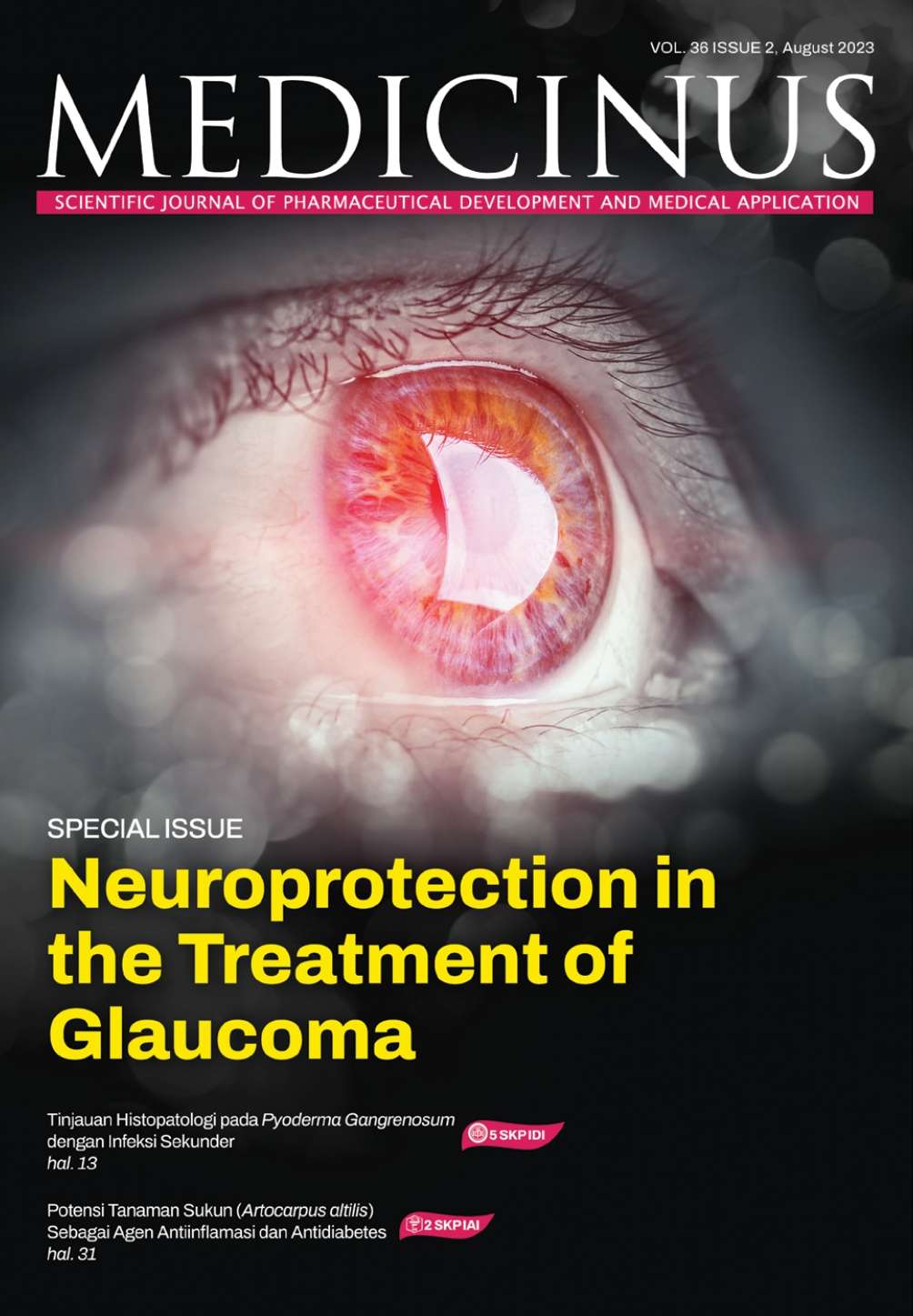Kasus Morfea Tipe Linier (En Coup de Sabre) pada Wanita Berusia 20 Tahun
DOI:
https://doi.org/10.56951/medicinus.v36i2.121Kata Kunci:
morfea, idiopatik, frontoparietal linear morpheaAbstrak
Latar belakang: Morfea merupakan penyakit inflamasi kronis yang ditandai dengan sklerosis pada kulit yang termasuk dalam kelompok penyakit sklerotik idiopatik. Wujud kelainan kulit pada frontoparietal linear morphea berupa plak linier atrofi unilateral pada dahi yang dapat meluas hingga alis, hidung, bibir, dan kulit kepala hingga menyebabkan terjadinya alopesia sikatrik. Tujuan laporan kasus ini adalah memberi gambaran tentang penegakan diagnosis frontoparietal linear morphea. Kasus: Seorang perempuan berusia 20 tahun datang dengan keluhan bercak berwarna coklat kehitaman di dahi. Pemeriksaan histopatologi menunjukkan pada lapisan epidermis tampak gambaran hiperkeratosis tipe basket-weave dan pendataran rete ridge serta sel-sel berpigmen di sel basal dermal-epidermal junction. Dari hasil pemeriksaan fisik dan histopatologi, pasien didiagnosis dengan frontoparietal linear morphea. Pasien diberikan terapi corticosteroid topikal dan sistemik. Diskusi: Morfea merupakan penyakit fibrosis langka pada kulit dan jaringan di bawahnya, di mana dapat terjadi penebalan difus, indurasi, dan atrofi. Pemeriksaan biopsi histopatologi dapat digunakan untuk menegakkan diagnosis dan menyingkirkan diagnosis banding. Biopsi histopatologi penyakit morfea fase awal dapat menunjukkan adanya inflamasi, dermis terlihat padat dengan serabut kolagen yang menebal disertai sebukan sel radang, terutama limfosit perivaskuler di antara serabut kolagen, pendataran rete ridges epidermis, dan atrofi. Terapi topikal dengan corticosteroid sebagai antiinflamasi dapat diberikan pada lesi aktif morfea liner tahap awal.
Unduhan
Referensi
Cyrus N dan Jacobe HT. Morphea and lichen sclerosus. Dalam: Kang S, Amagai M, Bruckner AL, Enk AH, Margolis DJ, McMichael AJ, Orringer JS, penyunting. Fitzpatrick’s Dermatology. Edisi ke-9. United States: McGraw-Hill; 2019.h.1106-16.
Mertens JS, Seyger MMB, Thurlings RM Radstake TRDJ, de Jong EMGJ. Morphea and eosinophilic fasciitis: an update. Am J Clin Dermatol. 2017;18(1):491-512. DOI: https://doi.org/10.1007/s40257-017-0269-x
Fett N. Scleroderma: nomenclature, etiology, pathogenesis, prognosis and treatments: facts and controversies. Clin in Dermatol. 2013;31(1):432-7. DOI: https://doi.org/10.1016/j.clindermatol.2013.01.010
Sehgal VN, Srivastava G, Aggarwal AK, Behl PN, Choudhary M, Bajaj P. Localized scleroderma / morphea. Int J Dermatol. 2002;41(8):467-75. DOI: https://doi.org/10.1046/j.1365-4362.2002.01469.x
Marsol IB. Update on the classification and treatment of localized scleroderma. Actas Dermosifiliogr. 2013;104(8):654-66. DOI: https://doi.org/10.1016/j.adengl.2012.10.012
Careta MF dan Romiti R. Localized scleroderma: clinical spectrum and therapeutic update. An Bras Dermatol. 2015;90(1):62-73. DOI: https://doi.org/10.1590/abd1806-4841.20152890
Rocken M dan Ghoreschi K. Morphea and liken sclerosus. Dalam: Bolognia JL, Jorizzo JL, Schaffer JV, penyunting. Dermatology. Edisi ke-3. USA: Elsevier; 2012.h.657-70.
Salgado PR dan Romero MTG. Morphea: a practical review of its diagnosis, classification and treatment. Gac Med Mex. 2019;155(5):483-91.
Bhat YJ, Akhtar S, Hassan I. Dermoscopy of morphea. Indian Dermatol Online J. 2019;10(1):92-3. DOI: https://doi.org/10.4103/idoj.IDOJ_350_17
Wang YK, Hao JC, Liu J, Liu YH, Jin HZ. Dermoscopic features of morphea and extragenital liken sclerosus in Chinese patients. Chinese Med J. 2020;133(17):2109-11. DOI: https://doi.org/10.1097/CM9.0000000000000977
Browning JC. Pediatric morphea. Dermatol Clin. 2013;31(2):229-37. DOI: https://doi.org/10.1016/j.det.2012.12.002
Fett N dan Werth VP. Update on morphea: epidemiology, clinical presentation and pathogenesis. J Am Acad Dermatol. 2011;64(2):217-28. DOI: https://doi.org/10.1016/j.jaad.2010.05.045
Aranegui B dan Reyes JJ. Morphea in childhood: an update. Actas Dermosifiliogr. 2018;109(4):312-22. DOI: https://doi.org/10.1016/j.adengl.2018.03.011
Zulian F, Athreya BH, Laxer R, Nelson AM, Oliveira SKF, Punaro MG, Cuttica R, dkk. Juvenile localized scleroderma: clinical and epidemiological features in 750 children: an international study. Rheumatology. 2006;45(1):614-20. DOI: https://doi.org/10.1093/rheumatology/kei251
Tjahyono E, Suhartono, Budiastuti A, Himbawani M. Frontoparietal linear morphea. Berkala IKKK. 2011;23(1):80-3.
Valinotti JCS, Tollefson MM, Reed AM. Updates on morphea: role of vascular injury and advances in treatment. Autoimmune Dis. 2013;46(7):1-8. DOI: https://doi.org/10.1155/2013/467808
Grabell D, Hsieh C, Andrew R, Martires K, Kim A, Vasquez R, dll. The role of skin trauma in the distribution of morphea lesions: a cross-sectional survey of the morphea in adults and children cohort IV. J Am Acad Dermatol. 2014;71(3):493-8. DOI: https://doi.org/10.1016/j.jaad.2014.04.009
Franco JPA, Serra MS, Lima RB, D’Acri AM, Martins CJ. Scleroderma frontoparietal linear morphea treated with polymethylmethacrylate - case report. An Bras Dermatol. 2016;91(2):209-11. DOI: https://doi.org/10.1590/abd1806-4841.20163867
Leitenberger JJ, Cayce RL, Haley RW, Huet BA, Bergstresser PR, Jacobe HT. Distinct autoimmune syndromes in morphea. Arch Dermatol. 2009;145(5):545-50. DOI: https://doi.org/10.1001/archdermatol.2009.79
Parti R, Regitnig P, Tauber G, Potscher M, Radisic VB, Kapp KS. Radiation-induced morphea: a rare but severe late effect of adjuvant breast irradiation. Strahlenther Onkol. 2018;194(11): 1060-5. DOI: https://doi.org/10.1007/s00066-018-1336-9
Suzanne C. Scleroderma in children and adolescent: localized scleroderma and systemic sclerosis. Pediatr Clin N Am. 2018;65(1):757-81.
Louis MP, Sperling LC, Wilke MS, Hordinsky MK. Distinctive histopathologic findings in linear morphea (frontoparietal linear morphea) alopecia. J Cutan Pathol. 2013;40(1):580-4. DOI: https://doi.org/10.1111/cup.12124
Corralo DS dan Tosti A. Trichoscopic features of linear morphea on the scalp. Skin Appendage Disord. 2018;4(1):31-3. DOI: https://doi.org/10.1159/000478022
Cuda JD, Moore RF, Busam KJ. Melanocytic nevi. Dalam: Kang S, Amagai M, Bruckner AL, Enk AH, Margolis DJ, McMichael AJ, Orringer JS, penyunting. Fitzpatrick’s Dermatology. Edisi ke-9. United States: McGraw-Hill; 2019. h.1967-9.
Vasquez R, Sendejo C, Jacobe H. Morphea and other localized forms of scleroderma. Curr Opin Rheumatol. 2012;24(6):685-93. DOI: https://doi.org/10.1097/BOR.0b013e32835896ce
Carli P dan Salvini C. Lentigines including lentigo simplex, reticulated lentigo and actinic lentigo. Dalam: Soyer HP, Argenziano G, Wellenhof RH, Johr RH, penyunting. Color Atlas of Melanocytic Lesions of the Skin. Berlin: Springer; 2007.h.290-4.
Kreuter A, Wischenwski J, Terras S, Altmeyer P, Stucker M, Gambichler T. Coexistence of liken sclerosus and morphea: a retrospective analysis of 472 patients with localized scleroderma from a German tertiary referral center. J Am Acad Dermatol. 2012;67(6):1157-62. DOI: https://doi.org/10.1016/j.jaad.2012.04.003
Pope E dan Laxer RM. Diagnosis and management of morphea and liken sclerosus and atrophicus in children. Pediatr Clin North Am. 2014;61(2):309-19. DOI: https://doi.org/10.1016/j.pcl.2013.11.006
Wardhana dan Datau EA. A patient with plaque type morphea mimicking systemic lupus erythematosus. Acta Medica Ind. 2015;47(2):146-52.
Owczarczyk-Saczonek A, Kasprowicz-Furmańczyk M, Kruszewska A, Krajewska- Włodarczyk M, Bechtold A, Klimek P & Placek W. The Correction of Facial Morphea Lesions by Hyaluronic Acid: A Case Series and Literature Review. Dermatol Ther (Heidelb). 2020;10:1423–34. DOI: https://doi.org/10.1007/s13555-020-00438-z
Unduhan
Terbitan
Bagian
Diterbitkan
Unduhan
Lisensi
Hak Cipta (c) 2023 Achmad Satya Negara, Arie Kusumawardhani

Artikel ini berlisensi Creative Commons Attribution-NonCommercial 4.0 International License.




